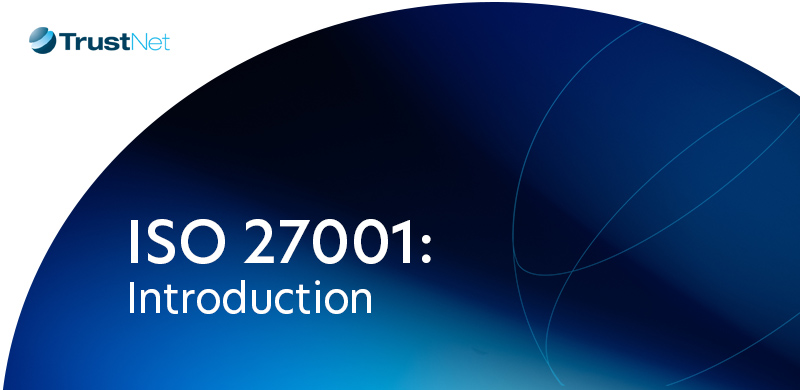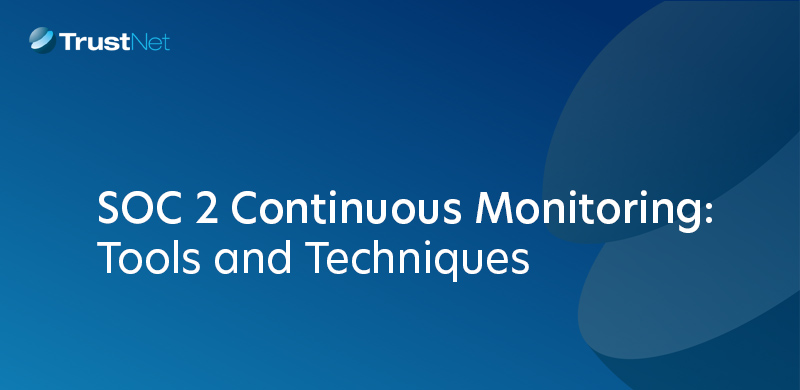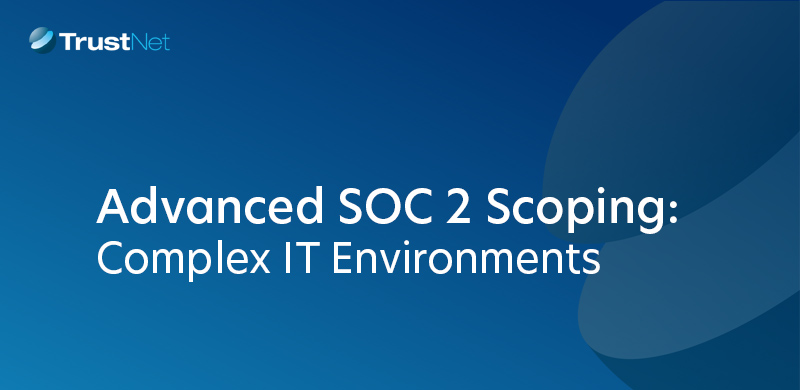Blog SOC 2 Compliance 101: All You Need to Know
SOC 2 Compliance 101: All You Need to Know

Protecting consumers’ personal information is crucial for modern businesses. SOC 2 is the industry standard for handling this significant responsibility to ensure dependable security procedures. This all-inclusive guide will explain the concept of SOC 2 compliance and its relevance, what the audit process entails, and how one can successfully carry it out.
Understanding SOC 2 Compliance
For technological service organizations, SOC 2 compliance is an essential component because it guarantees the highest level of information protection and confidentiality in the modern world.
What is SOC 2?
Systems and Organization Controls 2, or SOC 2, is a well-known technical audit that assesses how well a business protects consumer data. The American Institute of Certified Public Accountants (AICPA) introduced SOC 2 to regulate the handling of customer data by technology and cloud computing service providers.
Businesses must meet strict standards based on the five Trust Services Criteria — security, availability, processing integrity, confidentiality, and privacy — under this security framework.
While compliance isn’t legally mandatory for all organizations, achieving SOC 2 compliance demonstrates to customers and stakeholders that a company has robust data protection measures in place.
What Does SOC 2 Stand for?
SOC 2 is an acronym for Systems and Organizations Controls 2. The American Institute of Certified Public Accounts (AICPA) established this compliance framework to ensure service providers securely manage customer data, minimizing risk and exposure.
This set of criteria applies particularly to technology and cloud computing firms that store client information.
Every SOC 2 report center around five Trust Services Criteria: security, availability, processing integrity, confidentiality, and privacy as identified by AICPA. Adhering to these principles ensures a company’s system controls are designed effectively to keep their clients’ sensitive data secure from unauthorized access or potential breaches.
Why SOC 2 Compliance Matters
SOC 2 Compliance serves as a key differentiator in the increasingly competitive tech industry. It guarantees that cloud computing and technology firms have set robust security guidelines.
Successful completion of a SOC 2 audit assures clients and other parties that the organization has sound management practices for the protection of confidential information.
With SOC 2 compliance, risks associated with data breaches are significantly mitigated. Also, the financial losses from such incidents decrease dramatically. Maintaining a pristine business reputation is far more achievable by avoiding damaging headlines about data exposure or compromised customer details.
Therefore, fulfilling the requirements of SOC 2 is necessary for organizations that wish to safeguard the private information of their clients and earn their trust in such fast-changing digital times.
For more on our SOC compliance services, Click Here
Demystifying the SOC 2 Audit
A SOC 2 audit is a thorough evaluation that involves examining and assessing the systems and controls of an organization to determine if it meets the requirements of the Trust Services Criteria.
What is a SOC 2 Audit?
A SOC 2 audit is an evaluation of a company’s security measures and internal controls to assess its compliance with the Security Trust Services Criteria. It ascertains the efficiency levels of the organization’s mitigation strategies toward the safeguarding of confidential information, providing that the requisite security measures are in place.
The audit encompasses a variety of elements including confidentiality, availability, processing control, security and privacy for the purposes of compliance with the regulations.
SOC 2 reports come in two types: Type I provides a snapshot of a company’s controls at a specific point in time, while Type II evaluates control effectiveness over a period of time.
Audit Process, Timeline, & Costs
There are several steps in carrying out a SOC 2 audit, including scoping, readiness assessment, control testing and remediation, final assessment, and reporting. Let us delve deeper into the timeline and costs of the audit:
-
- Scoping: The first step is to determine the scope of the audit by identifying the systems and processes that need to be evaluated for compliance.
- Readiness Assessment: Next, a thorough evaluation is conducted to assess the organization’s readiness for the audit, which includes existing policies, procedures, and controls to identify any gaps or areas that need improvement.
- Control Testing: During this stage, the auditor examines the effectiveness of the organization’s internal controls by performing various tests and assessments.
- Remediation: If any weaknesses or deficiencies are identified during control testing, they must be addressed and remediated in order to meet SOC 2 compliance requirements.
- Final Assessment: Once all necessary controls have been implemented and tested successfully, the auditor performs a final assessment to ensure that the organization has achieved SOC 2 compliance.
- Reporting: Finally, an attestation report is issued by the auditor detailing their findings and providing assurance to stakeholders that the organization meets SOC 2 standards.
How to Prepare for an Audit
Preparing for an audit associated with demystifying the SOC 2 audit is crucial for companies. Here are key steps to help you prepare:
-
- Conduct a readiness assessment to identify areas of improvement before the audit.
- Document policies, procedures, and controls to demonstrate compliance with SOC 2 requirements.
- Security controls like access control, network protection, and incident reaction should be put in place.
- Engage with a third–party auditor to perform an independent evaluation of SOC 2 compliance.
- Continuously educate and train employees on security practices and compliance requirements.
Distinguishing SOC 2 Types
SOC 2 can be categorized into two types: SOC 2 Type I and SOC 2 Type II. Understanding the differences between such types is essential to determining the degree of compliance attained.
SOC 2 Type I vs Type II: What’s the Difference?
SOC 2 Type I and Type II represent different levels of assurance when it comes to data security and compliance. They differ mainly in the extent and timeline of the audit conducted.
|
|
SOC 2 Type I |
SOC 2 Type II |
|
Definition |
A SOC 2 Type I report evaluates an organization’s systems and whether they meet the trust services criteria at a specific point in time. |
A SOC 2 Type II report does the same but also checks how effective these controls are over a given period of time. |
|
Assessment Period |
This report is a snapshot of the organization’s controls at a particular moment in time. |
The assessment period for a Type II report typically extends over a minimum of six months. |
|
Assurance Level |
Provides assurance about the design and implementation of controls. |
It offers a higher level of assurance as it tests the operational effectiveness of controls over time. |
|
Preference |
Type I reports are often the first step for businesses pursuing SOC 2 compliance. |
Given their extensive testing period, Type II reports are becoming more preferred by customers as they offer greater assurance of the company’s security controls. |
Although both reports are helpful, a SOC 2 Type II report offers greater assurance since it covers a wide range of operational effectiveness of an organization’s controls over time.
— SOC 2 Type 1
SOC 2 Type 1 is a point-in-time assessment evaluating the design and effectiveness of a service organization’s controls related to security, availability, processing integrity, confidentiality, and privacy. This assessment provides a snapshot of an organization’s commitment to safeguarding sensitive data and enhances customer trust by validating the suitability of its controls.
Unlike SOC 2 Type 2, which reviews controls over time, SOC 2 Type 1 offers immediate transparency and helps businesses demonstrate their dedication to security and compliance.
— SOC 2 Type 2
Organizations seeking SOC 2 compliance may opt for a SOC 2 Type 2 audit. Unlike the Type I report, which assesses controls at a specific point in time, the Type II report evaluates control effectiveness over a period of time, typically six to twelve months.
Customers can feel more confident in an organization’s security protocols and the long-term dependability of its systems thanks to this thorough assessment. With a SOC 2 Type 2 report in place, companies can demonstrate their commitment to maintaining strong internal controls and provide proof that they have consistently adhered to industry standards throughout an extended duration.
The Importance and Benefits of SOC 2 Compliance
The importance of SOC 2 compliance to any organization cannot be overlooked since it enhances operational visibility, more protection, better security posture, reliability, and shorter sales cycles.
1. Operational visibility
Visibility into operations is one of the key aspects of achieving SOC 2 compliance. Companies must be able to see inside their systems and processes to achieve the required levels of security. This also assists businesses in being responsible and in providing proof for compliance efforts during audits, as evidence of ongoing measures is available.
2. Greater protection
SOC 2 compliance not only safeguards customer data from unauthorized access but also fortifies against security incidents and vulnerabilities. Thus, to avoid breaches of any kind, organizations put in place strict internal controls which provide a conducive environment for high security and win the trust of their clients.
3. Improved security posture
Implementing SOC 2 compliance enhances an organization’s defenses against unauthorized access and vulnerabilities. Robust internal controls position businesses as trustworthy partners in the marketplace by reducing risks, preventing data breaches, and fostering consumer trust.
4. Credibility
SOC 2 compliance establishes organizational credibility by adhering to rigorous security standards, protecting customer data, and differentiating from non-compliant competitors. This credibility fosters customer trust and opens opportunities for growth.
5. Faster sales cycles
Organizations seeking to enhance their sales are very much encouraged by SOC 2 compliance since it emphasizes their commitment towards security and privacy which gives potential customers peace of mind. It guarantees the safety of information, enhances the speed of making decisions and closing the deals more easily thus bringing in sales income.
Best Practices for Achieving SOC 2 Compliance
Security must be prioritized, monitoring must be continuous and gap-free, and incident reporting must be thorough to meet SOC 2 compliance.
– Prioritization
Prioritization in SOC 2 compliance is essential, requiring organizations to focus on the Trust Services Criteria: security, availability, processing integrity, confidentiality, and privacy. Assessing and ranking internal controls can enhance the protection of assets and support customers’ trust. This is not simply a strategic approach to protecting sensitive information only; it also aims to avert costly incidents of compromise and raise the security tier of the system as a whole.
– Consistent, Gap-free Monitoring
Consistent, gap-free monitoring is vital for SOC 2 compliance, which requires organizations to continuously track their security controls to meet the Trust Services Criteria. Businesses can quickly pinpoint and resolve weaknesses, allowing for continuous compliance with and proactive management of the risks associated with meeting SOC 2 requirements.
– Detailed Reports of Incidents
From a SOC 2 perspective, every incident should also be accompanied by a full account of events, further illustrating how well an organization’s internal controls are working and how successful the organization is when handling security-related problems. In this manner, organizations can instill confidence in their clientele and stand out from their rivals as they earnestly advertise their operations as secure.
Conclusion
Every organization that processes customer data must comprehend what it takes to become SOC 2 compliant. Particularly when guided by the Trust Services Criteria and subject to a SOC 2 audit, they can develop strong security controls and earn customers’ trust.
The ability to be SOC 2 compliant is not only for security and data protection but often comes as a competitive advantage and can propel a company into further business growth.
Contact TrustNet today to start your SOC 2 audit journey!




